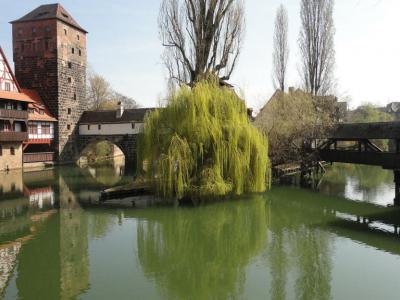
Maxbrücke (Max Bridge), Nuremberg
Max Bridge (Maxbrücke) is a historic stone arch bridge located over the Pegnitz River in Nuremberg. This significant structure sits in the old town area, linking Unschlittplatz in the Lorenz district to the south with Nägeleinsplatz in the Sebald district to the north. Built in 1457 by Jakob Grimm, a master builder from Rothenburg, it is recognized as Nuremberg's oldest stone bridge. Originally named the Stone Bridge, it features three sandstone bays with intricate tracery fillings made of cast iron.
The bridge's name was changed to Max Bridge in 1810 to honor the Bavarian King Maximilian I Joseph. Around this time, two round cannons were installed on the bridge to enhance the city's defenses against riverine attacks. The renaming also led to the adjacent Max Bridge receiving its current name, further cementing the bridge's royal connection.
Max Bridge faced significant damage due to a fire at the Nägeleinsmühle’s wooden water tower on its northern bank. It was subsequently restored and reopened in 1852 based on designs by Bernhard Solger. Today, Maxbrücke is not only a vital passage within Nuremberg but also a vantage point offering picturesque views of prominent city landmarks like the Weinstadel and Henkerssteg.
The Weinstadel, close to Max Bridge, is an emblematic medieval building originally serving as the imperial city's wine warehouse since around 1571. It is now one of the most celebrated architectural monuments on the Nuremberg Historical Mile. Nearby, Hangman's Bridge (Henkerssteg), also built in 1457, holds its historical significance. Originally constructed for the town’s hangman, it was rebuilt with a roof after a flood in 1595, adding to the old town’s charming historical ensemble.
Together, these structures encapsulate a rich blend of architectural beauty and historical depth, making Maxbrücke and its surroundings a focal point of heritage and culture in Nuremberg.
The bridge's name was changed to Max Bridge in 1810 to honor the Bavarian King Maximilian I Joseph. Around this time, two round cannons were installed on the bridge to enhance the city's defenses against riverine attacks. The renaming also led to the adjacent Max Bridge receiving its current name, further cementing the bridge's royal connection.
Max Bridge faced significant damage due to a fire at the Nägeleinsmühle’s wooden water tower on its northern bank. It was subsequently restored and reopened in 1852 based on designs by Bernhard Solger. Today, Maxbrücke is not only a vital passage within Nuremberg but also a vantage point offering picturesque views of prominent city landmarks like the Weinstadel and Henkerssteg.
The Weinstadel, close to Max Bridge, is an emblematic medieval building originally serving as the imperial city's wine warehouse since around 1571. It is now one of the most celebrated architectural monuments on the Nuremberg Historical Mile. Nearby, Hangman's Bridge (Henkerssteg), also built in 1457, holds its historical significance. Originally constructed for the town’s hangman, it was rebuilt with a roof after a flood in 1595, adding to the old town’s charming historical ensemble.
Together, these structures encapsulate a rich blend of architectural beauty and historical depth, making Maxbrücke and its surroundings a focal point of heritage and culture in Nuremberg.
Want to visit this sight? Check out these Self-Guided Walking Tours in Nuremberg. Alternatively, you can download the mobile app "GPSmyCity: Walks in 1K+ Cities" from Apple App Store or Google Play Store. The app turns your mobile device to a personal tour guide and it works offline, so no data plan is needed when traveling abroad.
Maxbrücke (Max Bridge) on Map






Sight Name: Maxbrücke (Max Bridge)
Sight Location: Nuremberg, Germany (See walking tours in Nuremberg)
Sight Type: Attraction/Landmark
Guide(s) Containing This Sight:
Sight Location: Nuremberg, Germany (See walking tours in Nuremberg)
Sight Type: Attraction/Landmark
Guide(s) Containing This Sight:
Walking Tours in Nuremberg, Germany
Create Your Own Walk in Nuremberg
Creating your own self-guided walk in Nuremberg is easy and fun. Choose the city attractions that you want to see and a walk route map will be created just for you. You can even set your hotel as the start point of the walk.
Nuremberg Introduction Walking Tour
The most "German" of all cities in Germany, Nuremberg has witnessed many historic events in its lifetime. Sadly, the first thing immediately associated with Nuremberg is the rise of the Third Reich, the Nazi rallies, and the postwar trials over the Nazi leaders. Indeed, the city was favored by Hitler, who planned to build here a grandiose architectural complex for his party.
... view more
Tour Duration: 2 Hour(s)
Travel Distance: 2.8 Km or 1.7 Miles
... view more
Tour Duration: 2 Hour(s)
Travel Distance: 2.8 Km or 1.7 Miles
Hitler's Nuremberg Tour
Despite Nuremberg's storybook appearance, the city's not so distant past is rather dark. Back in 1933, amid the rise of the Third Reich, the Nazis worked really hard to leave their stamp on the city, prettifying it and renovating the architecture in a bid to accommodate their massive rallies and bombastic military parades.
In fact, no other city in Germany is more intertwined with the... view more
Tour Duration: 2 Hour(s)
Travel Distance: 4.9 Km or 3 Miles
In fact, no other city in Germany is more intertwined with the... view more
Tour Duration: 2 Hour(s)
Travel Distance: 4.9 Km or 3 Miles
Nuremberg Old Town Walking Tour
The historical center of Nuremberg, Old Town (German: Altstadt) is easily differentiated from other parts of the city. Divided in two by the Pegnitz River, the district represents a complex architectural ensemble with a maze of historical lanes (e.g. Weissgerbergasse) packed with half-timber houses, linked by centuries-old bridges, such as Maxbrücke, and set against the picturesque backdrops of... view more
Tour Duration: 3 Hour(s)
Travel Distance: 3.8 Km or 2.4 Miles
Tour Duration: 3 Hour(s)
Travel Distance: 3.8 Km or 2.4 Miles



